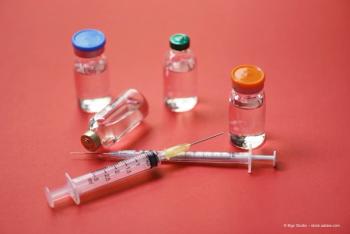
Angiogenesis 2024: Expanded efficacy data from the GATHER 2 trial
Sydney M Crago, the editor of Modern Retina, talks with Arshad M Khanani, MD, MA, FASRS, about the expanded efficacy data from the GATHER 2 trial for geographic atrophy (GA).
Sydney M Crago, the editor of Modern Retina, talks with Arshad M Khanani, MD, MA, FASRS, about the expanded efficacy data from the GATHER 2 trial for geographic atrophy (GA).
Video Transcript
Editor's note - This transcript has been edited for clarity.
Sydney M Crago:
Hi, I'm Sydney Crago with modern retina and I'm here today with Dr Arshad Khanani to speak about his presentation at the upcoming meeting. He'll be talking about the 2-year expanded efficacy data of the GATHER 2 trial. Dr. Khanani, can you tell us a bit about your presentation?
Arshad M Khanani, MD, MA, FASRS:
Thank you, Sydney. So my talk at Angiogenesis 2024 virtual meeting is, is about the expanded efficacy of avacincaptad pegol, or ACP. As you're aware that ACP is a small pegylated RNA aptamer that is designed to be a specific inhibitor of complement C-5. Based on the 2 positive pivotal, GATHER-1 and GATHER-2 studies, ACP received FDA approval in August of last year. In my talk, I'm actually sharing the expanded efficacy data, and there are a few things [that] I wanted to highlight from my presentation. First thing, we know that ACP monthly and every other month reduce GA growth versus sham in GATHER-2. As you recall, gather to is a multicenter, international randomized study where patients receive either monthly ACP in the first year, or sham, and then they were really randomized to receive either monthly or every other month dosing while the sham group continued with the sham injection.
So, the idea was to see if every other month can result in comparable efficacy as monthly, and that's what we saw. The other thing we notice is the treatment effect, we know that the treatment effect with ACP starts as early as 6 months. And what we saw was the treatment effect, more than doubled at over 2 years, compared to over 1 year with ACP, 2 milligram compared to sham. And then we also looked at the pooled analysis from GATHER-1 and GATHER-2. As you recall, GATHER-1 was a phase 2/3 pivotal study, and it was 18 months. So we wanted to see how pulling the data from GATHER-1 and GATHER-2 in terms of efficacy will give us more information about the treatment effect because we know that the GA is a very variable disease, and it's a multifactorial disease. So what we saw was, we saw robust efficacy of ACP in that analysis, and we saw an almost doubling of treatment effect every 6 months in the 18 months pool analysis with an overall reduction of 19% in GA growth compared to sham. Again, this is a postdoc analysis. And lastly, I presented the first time results of a match-adjusted, indirect comparative analysis or called medac analysis. And these analysis are done when level 1 evidence is missing in a head-to-head study. So we know that pegcetacoplan, which is also another drug that's approved for the treatment of GA.
That trial enroll patients with central and non-central point involving GA, well, patients in the ACP study, in all, were enrolled with non-centerpoint involvement. So, there are different baseline characteristics of each trial, but what we can do is we can match the baseline BCVA and GA lesion growth across trials and then look at the efficacy. So, we took all the publicly available data for pegcetacoplan DERBY and OAKS study, and then we matched the parameters of bcva GA and other parameters using the data from pivotal GATHER-1 and GATHER-2 studies. And then we ended up with a population that was actually very well matched. And again, this is not level 1 evidence this is done for for payers and regulators, especially when level 1 head-to-head evidence is missing. So what we saw was, we saw greater directional doubling of treatment effect with ACP monthly compared to pegcetacoplan monthly. So I think that is something very informative for the field that if we have similar baseline characteristics, we are comparing the efficacy so we saw a reduction over 12 months of 26% with ACP, in GA growth versus sham, and we use the same in sham from the same study. So we're not comparing the sham from a different study. While we saw a 14% reduction with pegcetacoplan in the similar group.
So we took all the data from DERBY and OAKS. And then we matched the patients from ACP in this analysis. So this was very important to find that with the match medac analysis, we saw greater benefit with ACP compared to pegcetacoplan. Of course, keeping all the caveats in mind about the limitations.
And the other thing we looked at which matters most for our patients is vision. So we looked at visual acuity in the sham group, and the match group for ACP. And then we looked at visual acuity in Derby and oaks with every month and every other month. And we saw that ACP monthly demonstrated greater vision preservation verus a sham compared to pegcetacoplan versus sham. So when you look at the data, there is 47% greater preservation of vision compared to share with ACP. And when you look at pegcetacoplan, in the monthly group, there is 17% less vision preservation. And in the every other month group, it's 65% less vision preservation. So this was another interesting finding that patients treated with ACP had greater vision preservation, which is obviously the ultimate goal of treating these patients long term with these therapies.
So I hope this summary of my talk was helpful to you and thank you for inviting me to share the summary of my talk.
Newsletter
Keep your retina practice on the forefront—subscribe for expert analysis and emerging trends in retinal disease management.










































